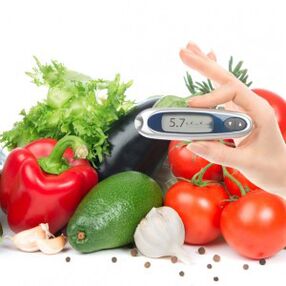
The diabetes mellitus diet is one of the methods of combating disease in order to prevent the development of acute and chronic complications. The main task of therapeutic measures is to normalize the metabolic processes in the body by optimizing the blood sugar level to the maximum permissible value.
The key to the patient's well-being is adherence to a diet with a limited amount of carbohydrates and selected drug therapy.
If treatment for the disease is not started immediately, diabetes mellitus complicates the kidneys, nervous system, blood vessels, eyes, and heart.
Etiology and pathogenesis
Today 4% of the world population suffer from this disease. According to the WHO, 8, 640 people die with diabetes worldwide every day, 3 million people every year. This number is many times higher than the mortality rate from hepatitis and AIDS. According to the International Diabetes Federation, as of 2014 the number of carriers of this disease is 285 million. At the same time, it is forecast to last until 2030. Their number may rise to 438 million.
Etiology of the disease:
- obesity;
- hereditary predisposition;
- viral infections (flu, tonsillitis) that damage the islet apparatus and form latent diabetes
- mental / physical trauma;
- autoimmune vascular diseases.
External factors that contribute to the development of diabetes:
- persistent psychological stress, stress, fear, anxiety;
- eating foods with excessive amounts of carbohydrates, saturated sugary substances;
- prolonged overeating.
Diabetes symptoms in men and women:
- weakness;
- polyuria (an increase in the amount of urine to 8 l / day);
- weight loss;
- hair loss;
- drowsiness;
- increased urination;
- intense thirst;
- decreased libido, potency;
- Itching of feet, palms, perineum;
- increased appetite;
- wounds do not heal well;
- decreased visual acuity;
- Smell of acetone from the mouth.
If you find any signs of disease, you should immediately consult a doctor, since the effectiveness of diabetes treatment is directly related to the speed of identifying the first symptoms of the disease, completing the diagnosis and conducting drug therapy. Remember that the disease is easier to treat in the early stages.
Disease classification and role of diet
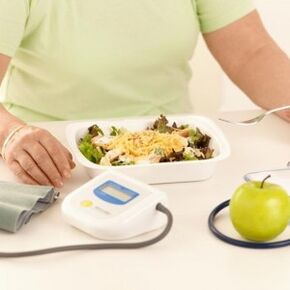
The primary role after drug therapy should be given to the patient's diet.
The type of diet depends on the stage of pancreatic depression, the mechanism of its manifestation and the method of treatment.
Degree of illness
- Type 1 diabetes. It is a serious autoimmune disease that has been linked to impaired glucose metabolism. When this happens, the pancreas does not produce enough or no insulin to maintain the body's vital functions.
- Type 2 diabetes. Often this form of the disease develops in sedentary people with old age, the body weight of which exceeds 15% of the total weight.
- Gestational diabetes. This type of diabetes mellitus occurs in 4% of women during pregnancy, more often in the second trimester. Unlike the first two types of diseases, in most cases it disappears immediately after the child is born, but sometimes it can turn into the second type of diabetes. . . .
Less common forms (variants) of diabetes mellitus that occur in 1% of the world population are prediabetes, latent, neurogenic, kidney, steroid, bronze, MODY.
Types of diabetes diets
Insulin injections, hypoglycemic medications, and physical activity are important to achieve positive dynamics in treating the disease. However, according to some doctors (A. Bronshtein, E. Malysheva, V. Kononov), proper nutrition plays a fundamental role.
Types of nutrition programs
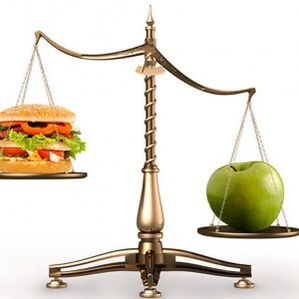
- A carbohydrate-free diet is a technique based on consuming complex carbohydrates from vegetables, fruits - in large quantities - and excluding foods with simple carbohydrates from the menu.
- Protein diet for diabetes. This diet is based on the principle of minimizing the consumption of carbohydrates and fats by increasing the protein content in the diet. The main focus of the methodology is on replacing meat with lean fish, poultry and fermented dairy products.
- Low carbohydrate diet used to compose menus for Type 1. 2 diabetic is used.
- Buckwheat diet. Regular consumption of this product has a positive effect on the body: it lowers the "bad" cholesterol level and saturates it with iron, rutin, calcium, magnesium, fiber, iodine and B vitamins. The buckwheat diet for diabetes helps minimize the chances of macrovascular complications and ulcers.
- The diabetes prevention diet is designed to reduce the risk of pancreatic dysfunction.
With the appearance of exacerbations of the heart system and blood vessels, diet 10 is practiced in diabetes mellitus. Its peculiarity is to reduce the consumption of liquids, salt, fats and carbohydrates, since these substances overload the liver, kidneys and nervous system.
Let's consider in detail what kind of diet is required for diabetes mellitus, recipes for dishes that are allowed to be consumed during the diet period
Carbohydrate count
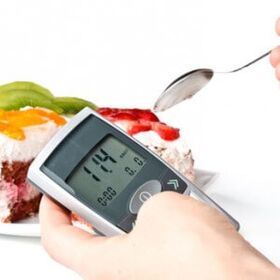
When diagnosing diabetes mellitus, it is important to properly balance the intake of carbohydrates and glucose-lowering substances in the body. To calculate the calorie content of products, a universal parameter called the bread unit is used. At the same time, 1 XE (10 - 13 g of pure carbohydrates) increases glucose to 2. 77 mmol / l and "requires" 1. 4 units of insulin for its absorption. Since the injection will be given before the start of a meal, it is important to plan ahead for the single meal.
The carbohydrate content of a meal should be 4-6 bread units. The frequency and time of meals is directly related to the type of sugar reducing drug.
Product quantity that corresponds to 1XE:
- sugar - 1 tbsp. ;
- honey - 1 tbsp. l. ;
- Spaghetti - 1. 5 tbsp. ;
- fruit juices - 150 ml;
- ice cream - 60 g;
- sweet water with gas - 180 ml;
- bread (rye, white, black) - 25 g;
- pancakes or pancakes - 1 pc. ;
- dough - 25 g;
- melon - 300 g;
- porridge (oats, buckwheat, wheat) - 2 tbsp. l. Grain;
- sausages - 200 g;
- kefir, fermented baking milk, milk - 250 ml;
- mashed potatoes - 100 g;
- apples - 100 g;
- legumes (peas, beans) - 5 tbsp. l. ;
- kiwi - 150 g;
- pears - 90 g;
- oranges - 100 g;
- berries - 150 g;
- plums - 100 g;
- peaches - 150 g;
- watermelon - 400 g;
- dried fruits (plums, raisins, dried apricots) - 20 g.
The carbohydrate saturation of the daily diet of a diabetic should not exceed 17 bread units (2000 kcal).
In addition to counting saccharides, it is important for patients with pancreatic dysfunction to carefully select foods for a meal based on prohibited and permitted ingredients.
| Product category | Allowed | Available in limited quantities |
Forbidden food |
|---|---|---|---|
| Baked goods | Detached | Wheat, whole grain, rye, second-class flour baked goods | Puff pastry, pastries |
| Meat and poultry | - | Lean veal, lamb, chicken, turkey, rabbit, boiled tongue, diet sausage | Fatty pork, beef, goose, duck, canned food, sausages, bacon, smoked sausages |
| First courses | Borscht, cabbage soup, fish soup, soups: mushrooms, fish, beetroot | Low-fat Solyanka | Noodle soups, rich broths, traditional kharcho |
| fish | Lean fish fillet | Mussels, squid, shrimp, oysters, crabs, fish of the salmon family (trout, salmon, salmon) | Eel, caviar, canned food in oil, fish of the herring family (sprat, sprat, herring), sturgeon (star sturgeon, beluga, sturgeon) |
| Dairy products, fermented milk products | Milk, kefir, unsalted cheese 25-30% | Homemade yoghurt, milk 0%, feta cheese, cottage cheese 5%, sour milk, fermented baking milk | Sour cream, cheese 50-60%, salted cheese, glazed quark, butter, condensed milk, cream |
| porridge | Buckwheat, pearl barley, oat flakes, barley, millet | - | semolina, brown rice, noodles |
| Vegetables | Carrots, cabbage (all kinds), beets, pumpkin, tomatoes, zucchini, aubergines, onions, beets, radishes, mushrooms, cucumbers, fresh leafy vegetables, peppers | Corn, boiled potatoes, fresh legumes | French fries, fried vegetables, pickled and salted vegetables |
| Fruits, berries | Quince, lemons, cranberries, pears | Plums, apples, peaches, oranges, cherries, blueberries, watermelons, raspberries | grapes, figs, dates, raisins, bananas |
| Desserts | Fruit salads | Sambuca, compotes, sweetener mousse, fruit jelly, green cocktails with honey (1 Dec. left) | Ice cream, cake, fat biscuits, cakes, jam, pudding, sweets, milk chocolate with nuts |
| Sauces and spices | Mustard, pepper, horseradish, tomato juice, cinnamon, dry spices and herbs | Homemade mayonnaise | Ketchups, sautéed vegetables, bought sauces |
| Drinks | Tea, cocoa, ground coffee (without sugar and cream), rose hip and raspberry boiling, unsweetened fruit nectars, sour berry fruit drinks | Natural vegetable juices (diluted) | Sugar lemonades, kvass, sweet drinks, alcohol |
| Fats | - | Vegetable oils (linseed, corn, olive sunflower), unsalted butter | Lard, meat fats |
After converting carbohydrates into bread units, it is important to determine the amount of insulin required to use the postprandial blood sugar. Following this recommendation will help avoid life-threatening conditions - hyper- and hypoglycemia.
Diet for diabetes grade 1
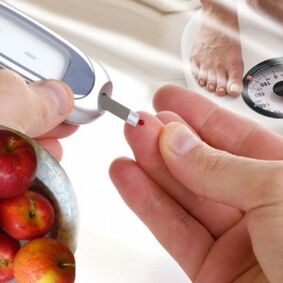
The type 1 diabetes diet is based on strict control of the blood sugar concentration at the level (3, 5… 5, 5 mmol / l).
Take into account the characteristics of food intake so that you can keep the level within the established limits.
- The maximum daily calorie content of dishes (total per day) is 2000 kcal.
- Fractional Nutrition (at least 5 times).
- Remove pure sucrose from the menu to lower blood sugar.
- Distribute the main dose of carbohydrates for breakfast and lunch.
- Don't eat at night.
- Avoid the consumption of easily digestible carbohydrates: baked goods, honey, jam, canned food.
- Use a natural sweetener as a sweetener.
- For monitoring the quality and "naturalness" of products.
- Adjust the schedule of insulin therapy for meals (a long-acting drug is injected before meals, a short one - after a meal).
- Calculate the number of bread units to take into account the amount of carbohydrates consumed per day. You shouldn't eat more than 8 XE for one meal.
In the case of gastrointestinal diseases (pancreatitis, ulcers, gastritis), the diet against diabetes mellitus prohibits the intake of products such as cucumbers, smoked meat, rich broths, coffee, carbonated drinks, alcohol, mushrooms, canned foods that cause excessive secretionof enzymes because they affect the rate and level of carbohydrate absorption.
Permitted type 1 diabetes foods:
- yeast-free baked goods (Lavash);
- berries, fruits (plum, cherry, lemon, apple, pear, orange);
- soy products (tofu, milk);
- cereals (pearl barley, oat flakes, buckwheat porridge);
- vegetarian puree soups;
- drinks (slightly carbonated mineral water, berry mousses, dried fruit compote);
- vegetables (onions, zucchini, peppers, beets, carrots);
- nuts (not roasted);
- weak coffee, unsweetened green / black / fruit teas.
Don't eat:
- rich soups, broths;
- pasta, flour products;
- sweets (cakes, pastries, candy, chocolate, muffins);
- Fast food, semi-finished products;
- alcoholic beverages (it is strictly forbidden to consume red dessert wine);
- sour, smoked, spicy dishes;
- Fatty meat (pork, lamb, duck), fish (mackerel).
The daily calorie intake of an obese patient on this diet with insulin is in the range of 1200 to 1400 kcal. In the absence of the need to get rid of extra pounds, servings of dishes can be increased.
Diet for one week for overweight insulin addicts
Day 1
- breakfast - bread - 1 slice, porridge - 170 g, green tea, cheese - 40 g;
- second breakfast - pear - 0. 5 pieces, young cheese - 60 g;
- lunch - borscht - 250 g, stewed cabbage - 200 g, vegetable salad - 100 g, steamed schnitzel - 100 g, lavash;
- afternoon tea - rose hip broth, cottage cheese - 100 g, fruit jelly - 100 g;
- dinner - cauliflower zrazy - 100 g, vegetable salad - 150 g;
- before going to bed - milk - 200 ml.
Day 2
- Breakfast - boiled veal - 50 g, green tea, omelette, tomato - 1 pc. , bread - 1 slice;
- second breakfast - grapefruit or orange - 1 piece, pistachios - 50 g;
- lunch - chicken breast - 100 g, vegetable salad - 150 g, pumpkin mash - 150 g;
- afternoon tea - grapefruit - 1 pc. , kefir - 200 ml;
- dinner - boiled fish - 100 g, stewed cabbage - 200 g;
- Bedtime - Unsweetened Cracker - 50 g
Day 3
- Breakfast - lavash, weak coffee without sugar, cabbage rolls with meat - 200 g;
- second breakfast - strawberries - 120 g, yogurt - 200 ml;
- lunch - pasta - 100 g, vegetable salad - 100 g, steamed fish - 100 g;
- Afternoon tea - orange - 1 pc. , dried fruit stock;
- dinner - cottage cheese casserole with pears - 250 g;
- before bed - kefir.
Day 4
- Breakfast - porridge - 200 g, green tea, cheese - 70 g boiled egg - 1 pc. ;
- second breakfast - toast with cheese, turkey fillet;
- lunch - braised zucchini with meat - 200 g, vegetarian puree soup - 150 g, bread - 2 pcs. ;
- afternoon tea - lean biscuits - 15 g unsweetened black tea;
- dinner - green beans - 200 g, boiled chicken fillet - 150 g, rose hip broth;
- before going to bed - dry food bread - 3 pieces.
Day 5
- breakfast - low-fat cottage cheese (up to 5%) - 150 g, kefir - 200 ml;
- second breakfast - pumpkin seeds - 2 tablespoons, raisins - 3 tablespoons;
- lunch - baked potatoes - 100 g, vegetable salad - 150 g, compote without sugar - 100 g;
- afternoon snack - unsweetened fruit tea, baked pumpkin - 150 g;
- dinner - vegetable salad - 200 g, steamed schnitzel - 100 g or pancakes with blueberries on rye flour - 250 g;
- before bed - kefir 1%.
Day 6
- Breakfast - boiled egg - 1 pc. , fruit tea, lightly salted salmon - 30 g;
- second breakfast - cottage cheese - 150 g, carrots - 1 pc. ;
- lunch - green borscht - 250 g, cabbage rolls with brown rice and carrots - 170 g; Pita bread;
- afternoon tea - kefir - 150 ml, bread - 2 pieces;
- dinner - fresh peas - 100 g, boiled chicken fillet - 100 g, steamed eggplant - 150 g;
- before bedtime - dry crackers - 50 g.
Day 7
- Breakfast - ham - 50 g, buckwheat porridge - 200 g, green tea;
- second breakfast - salad made from tuna, cucumber, cherry tomatoes, whole-grain rye bread - 150 g;
- lunch - stewed zucchini with carrots - 100 g, cabbage soup - 250 g, bread - 1 slice, chicken schnitzel - 50 g;
- afternoon tea - cottage cheese - 100 g, apricots or plums - 4 pieces;
- dinner - squid schnitzel with onions - 150 g dried fruit compote;
- before going to bed - milk - 200 ml.
A low-carbohydrate diet in diabetes is a strictly balanced diet for the patient to keep the sugar in the normal range and to lose it systematically.
Type 2 diabetes diet

Basics of nutrition health nutrition:
- replace refined carbohydrates with sweeteners;
- the ratio of BZHU should be 20%: 30%: 50%;
- reduces the consumption of animal fats by up to 50%;
The calorie content of the daily diet depends on the energy consumption and the patient's body weight.
Diabetes Diet 9 or Table 9 is a balanced program for diabetics with moderate to moderate obesity. The patient's diet consists of: proteins (100 g), carbohydrates (320 g), fats (80 g), 30% of which are unsaturated triglycerides.
The type 2 diabetes diet is almost the same as the nutrition program for people who monitor their health:
- Divide the total volume of daily food into 5 meals: 2 snacks at 1-2XE, 3 main meals at 5-8XE;
- don't skip breakfast;
- maximum break between meals - 4 hours;
- last meal in the evening - 1, 5 hours before bedtime;
- It is recommended to eat vegetable salads, fruit, freshly squeezed juices, dried fruit broth, kefir, milk, green or fruit tea, unsweetened biscuits (crackers) and bread between meals.
Everyday diet for type 2 diabetes
Day 1
- Breakfast - asparagus - 100 g, scrambled eggs from 3-4 quail eggs;
- second breakfast - salad of walnuts, squid, apples - 200 g;
- lunch - baked eggplant stuffed with pomegranate, nuts - 100 g, beetroot - 250 g;
- afternoon tea - avocado and cocoa ice cream - 100 g;
- Dinner - salmon steak with radish sauce - 200 g.
Day 2
- Breakfast - yogurt, oatmeal - 200 g (you can use stevia or agave nectar as a sweetener), apple - 1 pc. ;
- second breakfast - fruit smoothies (grind 80 g of each cherry, strawberry, melon and 4 ice cubes in a blender);
- lunch - baked veal - 150 g, vegetable stew - 200 g;
- afternoon tea - cottage cheese and pear casserole - 150 g;
- dinner - vegetable mixture - 200 g, avocado - half of the fruit.
Day 3
- Breakfast - fried eggs from two eggs with the addition of low-fat cheese, basil, tomatoes;
- second breakfast - "steam" vegetables - 100 g, hummus - 100 g;
- lunch - vegetarian puree soup - 200 g, green peas - 50 g, chicken schnitzel - 150 g;
- Afternoon tea - pear - 1 pc. , almonds - 50 g;
- dinner - salmon - 150 g, yogurt, spinach.
Day 4
- Breakfast - baked fruits (apples, plums, cherries) in agave nectar - 200 g;
- second breakfast - sandwich with tuna and salad;
- lunch - beef steak - 150 g, boiled cauliflower - 200 g, tomato salad, arugula, parmesan - 100 g;
- afternoon snack - fruit and berry dessert (sliced mangoes, kiwi, strawberries, combine with snow, pour orange juice and freeze) - 150 g;
- Dinner - broccoli roll - 200 g.
Day 5
- Breakfast - Orange - 1 pc. ; Fruit tea, low-fat cheese - 30 g, bread - 2 pcs . ;
- second breakfast - beet salad with nuts - 200 g;
- Lunch - rice - 200 g, salmon, steamed - 150 g, grapefruit - 1 pc. ;
- afternoon tea - berries with whipped cream 10% - 150 g;
- dinner - rose hip broth, squid schnitzel with onions - 200 g.
Day 6
- Breakfast - carrot and cottage cheese soufflé - 200 g;
- second breakfast - cauliflower zrazy - 100 g;
- lunch - salad made from tangerine, chicken breast, rocket - 200 g, dried fruit compote, vegetable borscht - 200 ml;
- afternoon tea - kiwi, raspberry mousse - 200 ml;
- Dinner - steamed cod with carrots - 200 g, kefir.
Day 7
- Breakfast - baked apple filled with oat flakes, nuts, raisins - 1 pc. ;
- second breakfast - fruit and vegetable salad from kohlrabi, celery, pears - 200 g, shrimp - 100 g;
- lunch - polenta - 200 g, vegetables, boiled hake - 200 g, kiwi - 1 pc. ;
- Afternoon tea - strawberries with mascarpone - 100 g;
- Dinner - cucumber salad with onions, spinach - 250 g, green tea.
Depending on the course of the disease, changes can be made in the patient's menu.
Remember that the sample diet above is not a universal nutritional system for all diabetics. Hence, it is important to monitor your wellbeing if you are following them. In the event of deterioration, “problematic” foods should be excluded from the menu.
Diet for gestational diabetes
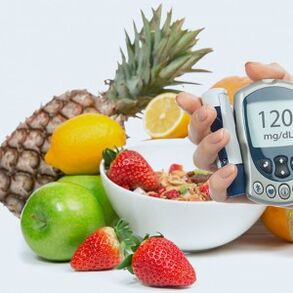
In some cases there is a malfunction of the pancreas in the body of the expectant mother, as a result of which gestational diabetes develops. In most cases, this condition is easy to control with proper diet.
Diabetes diet during pregnancy
- Eliminate sugar, confectionery, baked goods, semolina, sweet fruits and foods that contain sweeteners from your diet.
- Balance the menu of the day. The daily intake of carbohydrates is 50%, proteins - 30%, fats - 15-20%. At the same time, Malysheva's anti-diabetes diet minimizes food intake, which contains vegetable and animal triglycerides (5-10%).
- Observe the drinking regime - 1, 5-2 liters of water per day.
- Enrich your daily diet with starch (cereals, rye bread, brown rice, legumes, sweet potatoes, Jerusalem artichokes, radishes, beets) and fermented milk products.
- Snack on fresh fruit.
- Divide your daily food intake into 3 main meals (breakfast, lunch, dinner) and 2 snacks (lunch, afternoon snack).
- Enrich your daily diet with multivitamin complexes for pregnant women.
- Reduce sugar with folk remedies by decoiling celery roots, linden flowers, blueberry leaves, purple buds, and bean pods.
- Limit your caffeine intake. The permissible amount of alkaloids is 2 servings of coffee or tea.
The optimal calorie intake of the daily diet of a pregnant woman is 2000-2500 kcal. At the same time, a carbohydrate-free diet is forbidden in gestational diabetes.
Recommended menu for expectant mothers with high blood sugar
- Breakfast - millet porridge - 150 g, fruit tea, rye bread - 20 g;
- second breakfast - dried wholemeal bun - 50 g, unsalted cheese 17% - 20 g, apple - 1 pc. ;
- lunch - buckwheat porridge - 100 g, a mixture of cabbage, Jerusalem artichoke, cucumber - 150 g, beef stew - 70 g;
- Afternoon tea - cottage cheese 5% - 100 g, unsweetened cracker - 2 pieces, orange - 1 piece. ;
- dinner - boiled chicken fillet - 60 g, vegetable garnish (carrots, cabbage, peppers) - 100 g, tomato juice - 180 ml, bread - 2 pcs . ;
- 3 hours before going to bed - kefir / yogurt - 200 ml.
In addition to a special diet, patients with gestational diabetes are shown walking (40 minutes a day) and doing moderate physical activity (gymnastics, water exercises).
Diet for insulin-dependent diabetes in children
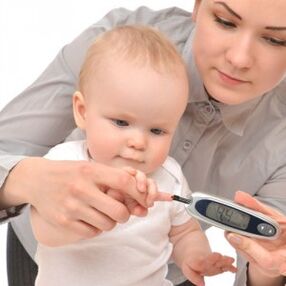
Diabetes mellitus in childhood and adolescence is much more difficult to bear than in adults. A child's genetic makeup, stress, and poor diet are the main causes of autoimmune disease.
In 80% of cases, children are diagnosed with insulin-dependent diabetes (type 1). Early diagnosis, immediate treatment and strict adherence to a special diet will help prevent the consequences of the disease.
Diabetes diet in children
- Exclude sugar, soda, confectionery, baked goods made from wheat flour, fried foods and baked goods from the menu.
- Enrich your daily menu with unsweetened fruit, vegetables and herbs (unlimited). Prohibited - grapes, bananas, raisins, dates, persimmons, figs.
- Use natural sugar substitutes.
- Divide your daily food intake into 6 meals. At the same time, it is important to eat at regular intervals. Permissible deviations in the child's nutrition plan are 15–20 minutes.
- Meals should be taken after 15 minutes. after the introduction of insulin and 2 hours after the injection.
- If you can't eat at the appointed time, you can eat bread, pear, nuts, cheese sandwich or apple as a snack. In no case should you starve to death.
- If you take a slice of chocolate right away, you can stop hypoglycemic seizures. Therefore, an adult accompanying a child should always have a sweet product available.
- Enrich the child's daily diet with fermented milk products.
- Calculate your daily fructose intake. The amount of sugar substitute depends directly on the age of the child and the nature of the course of the disease.
To lower blood sugar, it is advisable for a child to prepare blueberries, nettles, corn stalks, mint leaves, barberry branches, bean pods, Jerusalem artichoke fruits, ginseng and eleutherococcus.
Therefore, the diet of patients with diabetes plays an important role, since the patient's well-being and life depend on the correctness of its composition. It is therefore important to take the composition of the diet and its compliance very seriously and carefully, otherwise negligence can lead to tragic consequences.






























